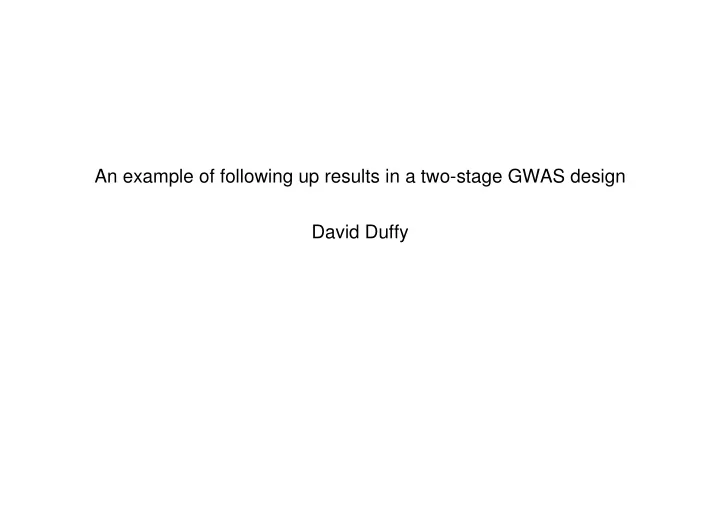

An example of following up results in a two-stage GWAS design David Duffy
In a 100K Affymetrix-based GWAS we carried out in 2006-7, one SNP on chromosome 19 exhibited particularly strong association to our phenotype of interest, nevus count. The original result causing such excitement (275 usable obs). The P-value ignores the relatedness of the twins. Moles rs3848620 Mean SD Count --------------------------------------- 1/2 108.2075 48.9109 53 2/2 73.4730 41.3354 222 Kruskal-Wallis H= 24.07 df= 1 (P=0.0000) We were slightly cautious about this accepting this result, because none of the neighbouring SNPs gave any evidence of association to nevus count. However, this SNP was not in strong LD with any neighbours. In addition, this SNP has been removed from later Affymetrix arrays, presumably because of assay problems, but no information was available.
Therefore, we carried out additional genotyping on the Sequenom platform. Marker NAll Allele(s) Freq Het Ntyped -------------- ---- ----------- ------ ------ ------ rs3848620 2 1 (2) 0.1079 0.1928 329 Original rs3848620F 2 A (G) 0.3515 0.4560 3799 Forward rs3848620R 2 A (G) 0.3539 0.4574 3745 Reverse We found the minor allele frequency to be quite different from the original genotyping. Crosstabulating the old and new assays, the Affymetrix assay is adequate for the G/G homozygotes, but the A/A and A/G were pretty bad. rs3848620F rs3848620 A/A A/G G/G ------------------------------------- 1/2 45 (.662) 23 (.338) 0 (.000) 2/2 0 (.000) 58 (.249) 175 (.751)
Even the two different Sequenom assays disagreed with one another in a few cases - the rs3848620R assay also gave more Mendelian errors. One would presume a proportion of true A/G heterozygotes are being called as A/A by the reverse strand assay. This is a classical pattern of assay error. Even so, the overall agreement was 99.7% rs3848620R rs3848620F A/A A/G G/G --------------------------------------- A/A 489 (1.00) 0 (.000) 0 (.000) A/G 10 (.006) 1653 (.994) 0 (.000) G/G 0 (.000) 0 (.000) 1592 (1.00)
And, the new assay in the original subsample (250 usable obs) still gave nice evidence of association: Moles rs3848620F Mean SD Count --------------------------------------- A/A 121.9697 44.4512 33 A/G 71.8857 46.5345 70 G/G 75.8707 39.5901 147 Kruskal-Wallis H= 32.08 df= 2 (P=0.0000)
But, using all the available observations. V1.NF rs3848620F Mean SD Count --------------------------------------- A/A 91.7244 53.7296 225 A/G 83.3560 46.2774 795 G/G 87.3276 52.5656 760 Kruskal-Wallis H= 3.66 df= 2 (P=0.1605)
The figure shows the relationship between genotype, residualized nevus count and year of examination. The Affy 100 K sample were all examined in 2001-2003.
Recommend
More recommend